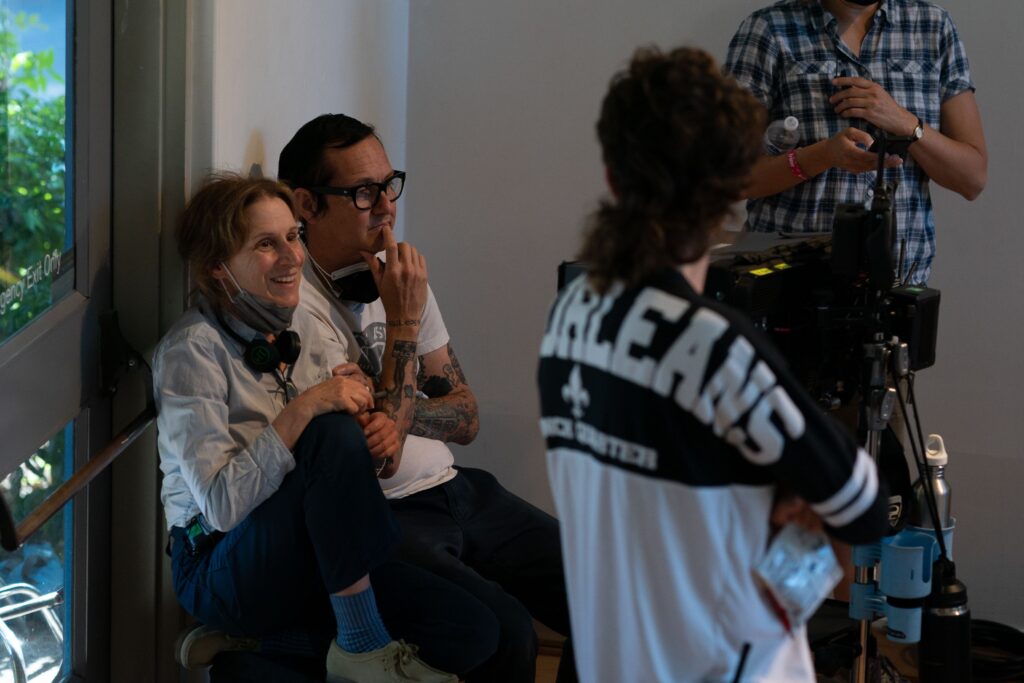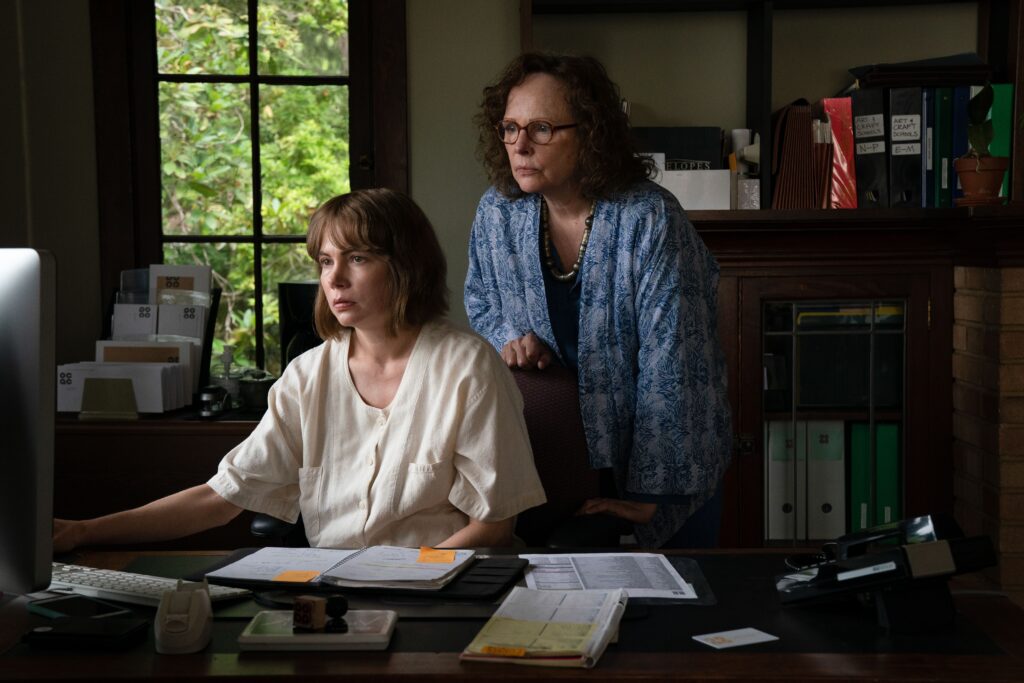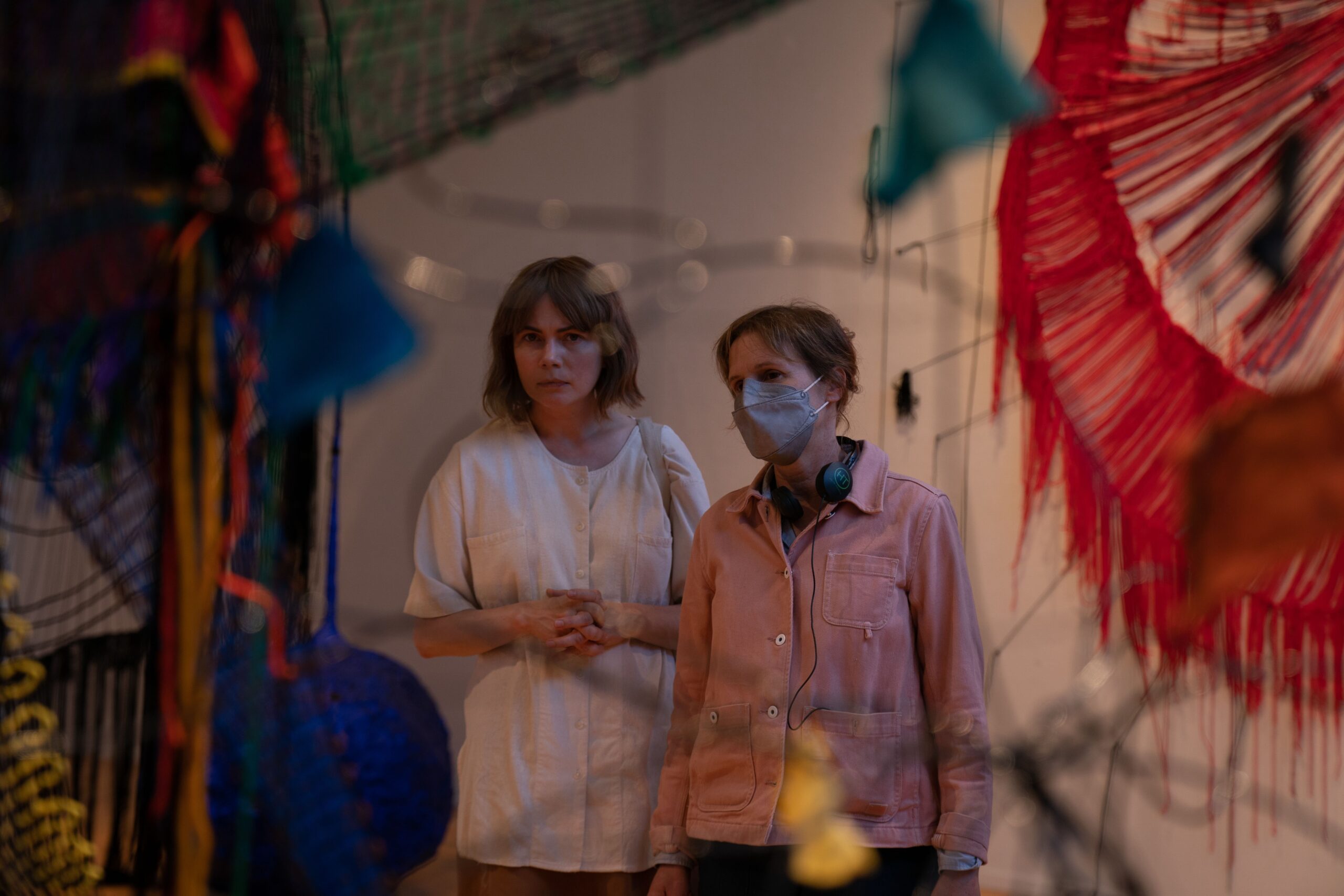Filmmaker Kelly Reichardt—whose three-decade career as an independent filmmaker specializing in spare, minimalist excursions—is an artist freed from American commercial sensibilities; a nonconformist favoring nuance over plot and ambiguity over resolution.
In pictures like Wendy and Lucy, about a young homeless woman searching for her missing dog across the Pacific Northwest, Meek’s Cutoff, charting the perilous trek of wagon train pioneers, Certain Women, concerning a triptych of ordinary lives in the modern West and First Cow, in which an unlikely friendship during the gold rush upends paradigms of both capitalism and frontier masculine archetypes, Reichardt applies a minimalist, methodical design, which sometimes feels less story and more abstract observance. In addition to being revered as a world-class filmmaker, Reichardt is also an Artist-in-Residence at New York’s Bard College where she teaches film, a dual vocation one hopes will impart Reichardt’s singular ethos on future generations of filmmakers. We could use a few more like her.
I recently caught up with Kelly Reichardt at the Chicago Athletic Association for a chat about her new film, Showing Up, perhaps her most self-reflective to date in its look at a harried working artist, featuring Williams as a sculptress who must navigate a flurry of life issues in the run up to an exhibit of her new work. Much of the film takes place in and around a fictional liberal arts college, which one imagines could well be reflective of Reichardt’s alma mater, Boston’s School of the Museum of Fine Arts, or perhaps even her close to two decades at Bard. The expectedly observant picture is also frequently amusing and quietly profound in its view of what it takes for an artist to create—navigating the banal responsibilities of day jobs, family dramas and unexpected distractions while finding the time and resources to create and commune with one’s passion.
Lee Shoquist: I admired Showing Up is its portrait of a community of artists working day in and out to create.
Kelly Reichardt: Yes.
These are people who are working in other jobs all day, creating art when they can, pulling all-nighters and always trying to fit their passion into their daily lives. It is also not a satire of the art world, which we have seen many times. It is more of an ode to the artistic spirit in everyday people whose work may never end up in a major museum but still they forge on.
You said it all. Yes, all those things. I think it is a film about the process and routines that you set up for yourself of getting to the table or studio every day, which is mixed in with buying groceries and paying rent and dealing with your family or whatever it is. And also to concentrate on artists and what it is like to go to work every day and not necessarily have a built-in audience. I remember (artist) Michelle Segre saying that to me about filmmaking: ‘There is a built-in audience when you are a filmmaker. There is not when you are a sculptor.’
We had three people whose art we liked that we wanted to use in the film, but also we got a lot of local art from people we loved. Inside the apartment is the work of Storm Tharp, who is a very dear friend of mine, and his studio is really Jo’s studio in the film. And our friend Mike Brophy—his are those huge paintings we see when the guy is vacuuming at the school. We have gone on a million scouting trips together and I would take pictures and he would make storyboards, as he did for Night Moves and Meek’s Cutoff, and then some of location photos became his paintings. So it’s all mixed in. Chris Johanson and JoAnna Jackson have their work in the film. There is a lot of good art in different places so that was nice.

I loved seeing the artist working with her hands in the film, not just Michelle but Hong Chau…
Yes, Hong is using her whole body.
Yes, there is a beautiful moment where she is on the floor of the studio almost wrestling it to the ground.
Yes!
And then Michelle’s Lizzy character spending so much time alone doing this. Right from the opening credits where we see all of the artwork, it is given its due in the film through the various stages of creation. We often look at it in long takes and we are invited to consider the process of how it has come to be. There is a great moment where Michelle takes the arms off the sculpture she’s creating and refashions them. And then the moment where she finally brings them all to the gallery, which is sort of this all-white space, and the figures are all arranged in front of her and she’s perfectly placing them to get them exactly right.
Right! Which isn’t really her job (laughter). It’s a shared thing.
Let’s talk about your work with Michelle Williams. Here’s someone diametrically opposed in every role and one of our very best actresses. You’ve made several films together. She is part of your ensemble and maybe the actor with whom you have most worked.
Maybe. Probably yes.
What is between you as director and actor? What is the adventure that you have together each time?
With us it is pretty easy. If I call Michelle she will say, ‘What are we doing?’ She is ready. She goes all in and is very quick to talk to. You don’t have to butter anything up. And there is a lot of trust between us. She’s brave. She’ll try things. So it’s just an easy ride, really. Nothing about filmmaking is easy but working with Michelle is pretty easy. Working with Hong was easy.
I had this experience on First Cow where I didn’t really know what the dynamic between John Magaro and Orion Lee would be until the first day they came. They met each other and were in their costumes together. And then as the film goes on I said, ‘Wow, I am so fortunate.’ Because while I really loved both of their readings, Magaro seemed to have a lot of qualities of Cookie and Orion a lot of qualities of King-Lu. But you don’t really know until you meet people and know them on a movie set. I have come to learn that that is essentially true. And with Hong and Michelle- Hong is very much about showing up and doing her thing. (I would say) ‘How can I help you?’ and she would reply, ‘No, I’m fine.’

You mentioned John Magaro. He has a wonderful monologue where his character has dug a hole the ground and Michelle approaches him and mentions ‘Earth work.’ I’m going to paraphrase what he replies, which is that people don’t often hear because they don’t want to hear. Beautifully delivered. I also like that she admitted she could not hear it. I thought he added much to the film during only a few scenes.
Yes. So do I. He is just fantastic. I also credit Jon Raymond with writing that scene because it is very nicely written, and they both play it so well. I think John really adds a lot to the whole family dynamic in the film. He is fantastic.
Let’s talk a bit about your style. It’s often called minimalist. Sometimes it’s called social realist. Maybe it’s both of those things. In American movies today, there certainly are not many filmmakers, at least in the mainstream, that chronicle social realism. Maybe in other eras we did have those types of stories, primarily the 70s, but we don’t seem to have them anymore. What do you think about that? Would you ever consider applying those qualities to commercial movies in some way and perhaps restore them to real life substance?
I think that’s too abstract of a question for me to get my head around. I think in the way we work, through the work on the script, I have sort of figured out what my filmmaking is going to be. That comes by way of a lot of hanging out and coffees and I don’t know… I work around my teaching schedule. I have been lucky to make films that are where I can go and edit them and say, ‘Okay, I am done. Here is the film.’ That is a pretty amazing thing. A24 and, previously, Oscilloscope supporting the films and letting them be what you want them to be is, knock on wood, a good thing. They have their place in the world and that is not (commercial filmmaking). I don’t know if you could apply that to a more commercial brand of filmmaking because it is not really hitting all the notes that hard.
You seem to be attracted to characters on the periphery, as they call it, in some way. Maybe they are ordinary people who are striving and not always toward huge goals.
It’s a funny thing because we look at it as people on the periphery, but…
It’s most people, right?
Yes! It is everybody. People on the periphery are just this idea of- whatever kind of life is portrayed in Hollywood filmmaking is the real periphery, I think. It is what movies get made about. But it is not- I mean, we are talking real lives. There are more of those than there are of whatever we are calling not real lives here. I think there’s room for a lot of different kinds of filmmaking. In some systems- I’m a huge Mike Leigh fan but he could never have worked in the States as things are just not sent up that way: ‘What do you mean, you are spending a year with actors? What are you talking about?’ So it is good he is where he is so he can make all of that great work.

Do you ever feel discouraged about this industry that we are getting further and further away from films in the commercial realm that talk about the human experience?
I really do not have that bird’s eye view on it. I have my little world that I am making movies and teaching in, so I don’t really have a big read on it.
You cut your own films also, right?
Yes.
How is that for you when you look at the footage, pace it, decide how it moves and ends. Tell me a bit about that.
It’s fun. I have this editing assistant named Ben Mercer who over the years has done lot of things but has become really involved in the sound while I am cutting and building the sound design. He is not in the room when I am there, but he comes in like a mouse in the middle of the night and I leave him notes and he works on the sound. That sound work is great. Anyway, I like getting back into the room by myself after it has been so collaborative. It’s nice. At first, I have to sneak up on it and watch a little bit at a time. And then I do a long assembly as I am getting to know the footage. Then I start carving away at what it’s going to be.
But I like the process a lot because I find many things along the way and check out all of the possibilities. It keeps me with my hands on something. I mean, I am pretty out of it as far as technology goes, and this keeps me- when I’m talking to my students, (I know) about how something works (laughs). And if anything goes wrong then Ben Mercer fixes it. But I really like the process. For me, it helps me decide- when you are deciding how to shoot something and what the shooting scheme will be, you are thinking about the cut all of the time. It informs a lot of things.
You had an interest in photography when you were young.
Yeah, I did!
Was there a pivotal moment when you said I’m going to be a filmmaker?
Yeah. I was in Miami. I was fighting with someone, and I said, ‘I’m going to be a director!’ And then I got into my Volkswagen and was driving on I-95 and said, ‘I said that with such assurance! I want to know what a director is!’ (laughter). But when I was a kid it was pretty funny. I thought it would be like out in the- what is her name, with the gorillas?
Jane Goodall?
Yes, Jane Goodall. I would be like Jane Goodall but with a camera, which is hilarious to think about because I’m terrified of insects and all of the things that are in the jungle. It would never have cut it! My dad was a detective and did crime scene photography. So he always got me a lot of film. I guess it was expired and they could not use it anymore. And back in the day he got me a Pentax K1000, which I think a lot of kids started with. That was when I was really young though. But eventually I did think about putting things in motion.
When I got to Boston, I met a bunch of artists getting ready for an art party that was going to happen. They decided they were going to make films and wanted to be in them, but they did not know anything about filmmaking. So I crashed at their house and signed up the School of Visual Arts in Boston and started getting equipment and making these little films for these different artists. That was kind of the diving in point. And then I ended up at the School of the Museum of Fine Arts, which was really a painting and drawing school. I think there were about eight kids interested in filmmaking and the school had not decided if that was going to be allowed yet. There were some Bolexes and Super 8 cameras.

Were you also cutting on Steenbeck?
Yes.
Totally different time, right?
Really different time, yes.
You said a moment ago that you proclaimed at a very young age that you were going to be a director. Maybe not even knowing what that would be.
Yes. I was just talking shit.
But here you are much later, and you are quite a significant director. What does it mean to you now versus what you thought it meant at that time?
Oh, who knows? Well, I like thinking about shots and where the camera goes, and I have a great collaborator with (cinematographer) Chris Blauvelt. One of the great things in life is doing that. There are many parallels to filmmaking and teaching. There is a community up there and a community in filmmaking. My life is really very- I don’t know what you’d call it. Sometimes I think I have to make films because I have to crank it up a little for a little while. Action! And then you have something to edit for the next year. I don’t know. It is nice to have a project and I like to have something to think about. It helps you to sort of filter the world. So you do that for as long as you can.
Speaking of where the camera goes, you make some of the most striking images. Sometimes I think about your films and the imagery is so original and really stays in the memory. For example, the shot selection while crossing the river at the opening of Meek’s Cutoff. In Showing Up, many of the shots of Michelle arranging her work, such as the shot set in the gallery as I mentioned earlier.
Oh thanks, I like that shot too.
I wish it wasn’t the case, but we have to wrap.
Lovely to meet you.
You as well. Thanks so much.
This interview has been edited for length and clarity.



